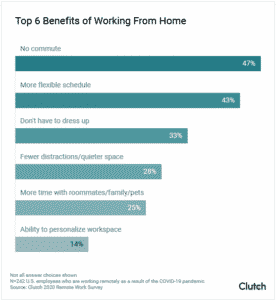With the world continuing to struggle through an unprecedented crisis, more and more businesses, and their employees, have been forced to work from home to keep things going. In a recent survey done by software provider Clutch Company, they have discovered that 66 percent of current American workers are working from home. The following results are taken directly from their survey:
- Clutch surveyed 365 workers across the country about their working-from-home habits and what they like and dislike about remote work. We found that 66% of employees currently work from home at least part of the week as a result of the coronavirus outbreak.
- Nearly half of U.S. workers (44%) are currently working from home 5 or more days per week as a result of the coronavirus outbreak, up from 17% before the pandemic.
- There isn’t a consensus on workers’ preferred workspace: 39% would prefer to work in an office, while 40% would rather work remotely.
- Not having a commute (47%), a more flexible schedule (43%), and not having to dress up (33%) are the three biggest benefits of working from home.
- Difficulty collaborating with co-workers (33%), frequent interruptions (27%), and problems sticking to a routine (26%) are the three biggest challenges of remote work.
- The top collaboration tools for remote workers are Zoom (36%), Microsoft Teams (19%), and Skype (17%).
- About two-thirds of employees (66%) are currently working remotely at least once per week as a result of the COVID-19 outbreak.Before the coronavirus pandemic, 17% of U.S. employees worked from home 5 days or more per week. Now, that number is up to 44%.
- Thirty-nine percent (39%) of workers would rather work in an office, while 40% would rather work remotely. About 21% have no preference. The average American spends 4.35 hours a week commuting. Remote work brings many Americans’ commute time down to just a few seconds — walking from one room to another. This is the biggest benefit of working from home, according to U.S. employees.
-Written by Kevin Sawyer




